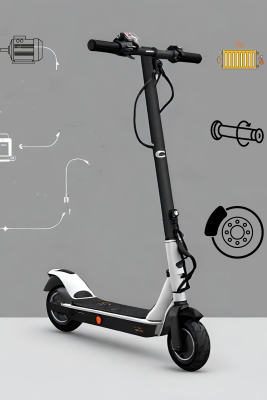Ride on Cars
The Science Behind Kids Electric Scooters: How Do They Work
How do kids’ electric scooters function?
Kids electric scooters are becoming increasingly popular as a fun and eco-friendly mode of transportation for children. These scooters are powered by an electric motor and are designed to be safe and easy to use for young riders. Understanding how these scooters function can help parents make informed decisions when choosing the right scooter for their child.
Overview of the basic components and mechanics
Kids electric scooters are made up of several key components that work together to provide power and control. These components include the electric motor, battery system, throttle, brakes, and wheels.
Motor
The electric motor is the heart of the scooter and is responsible for propelling it forward. It is typically located near the rear wheel and is connected to the battery system. When the motor receives power from the battery, it spins the wheel, allowing the scooter to move.
Battery System
The battery system is what powers the electric motor. It is usually a rechargeable lithium-ion battery that is located somewhere on the scooter, either under the deck or in a removable compartment. The battery is connected to the motor and provides the necessary electrical energy to make the scooter run.
Throttle
The throttle is the control mechanism that allows the rider to accelerate or decelerate the scooter. It is usually a twist-grip or thumb-operated lever located on the handlebars. When the rider twists or pushes the throttle, it sends a signal to the motor, instructing it to either increase or decrease the speed.
Brakes
The brakes on kids’ electric scooters are designed to provide reliable stopping power. They can be either mechanical or electronic. Mechanical brakes work by applying pressure to the wheel, slowing it down and eventually stopping it. Electronic brakes, on the other hand, use the motor to slow down the scooter by reversing its rotation. Both types of brakes are effective, but electronic brakes are generally more precise and responsive.
Wheels
The wheels of kids’ electric scooters are typically made of durable materials like rubber or polyurethane. They are designed to provide a smooth and stable ride while also offering good traction and grip on various surfaces.
Explanation of the electric motor and battery system
The electric motor is the key component that powers kids’ electric scooters. It converts electrical energy from the battery into mechanical energy, which is used to rotate the wheels and propel the scooter forward. The motor is usually brushless, which means it has fewer moving parts and requires less maintenance compared to brushed motors.
The battery system of kids’ electric scooters is crucial for providing the necessary power to the motor. Lithium-ion batteries are commonly used due to their high energy density, long lifespan, and lightweight design. These batteries can be recharged using a standard electrical outlet, and the charging time can vary depending on the scooter’s battery capacity and the charger’s output.
It is important to note that the performance of the electric motor and battery system can vary between different models and brands of kids’ electric scooters. Higher-end scooters may have more powerful motors and larger battery capacities, allowing for faster speeds and longer riding distances.
Understanding the safety features of kids’ electric scooters
Safety is of utmost importance when it comes to kids’ electric scooters. These scooters are designed with several safety features to ensure the well-being of young riders. Understanding these features can help parents choose a scooter that provides a safe riding experience for their child.
Importance of safety features for young riders
Young riders may have a different level of coordination and judgment than adults, making safety features essential for their protection. These features help prevent accidents and injuries by promoting responsible riding and providing additional control over the scooter’s speed and performance.
By having safety features in place, parents can have peace of mind knowing that their child is riding a scooter that prioritizes their safety.
Discussion on features like speed limiters, braking systems, and lights
Speed limiters are one of the most important safety features found in kids’ electric scooters. These devices allow parents to set a maximum speed for the scooter, ensuring that the child does not ride too fast. Speed limiters are typically adjustable and can be set to match the child’s skill level and comfort.
Braking systems are another critical safety feature. Kids electric scooters are equipped with either mechanical or electronic brakes, as mentioned earlier. These brakes provide reliable stopping power and allow the rider to slow down or come to a complete stop when necessary. Parents need to ensure that the scooter’s brakes are in good working condition and properly adjusted.
Lights are also an essential safety feature, especially if the child will be riding the scooter in low-light conditions or at night. Many kid’s electric scooters come with built-in headlights and taillights, making the scooter more visible to other road users. Lights not only enhance visibility but also contribute to the overall safety of the rider.
In addition to these features, some kid’s electric scooters may also have additional safety features such as reflectors, fenders, and non-slip foot decks. Reflectors increase the visibility of the scooter, especially when riding in low-light conditions. Fenders help protect the rider from debris and water splashes, while non-slip foot decks provide a secure footing for the child.
Choosing the right kids’ electric scooter
When it comes to choosing the right kids’ electric scooter, there are several factors that parents should consider. These factors will help ensure that the scooter is suitable for the child’s age, size, and skill level.
Factors to consider when selecting a scooter for your child
Age appropriateness is an essential factor to consider when choosing a kids’ electric scooter. Different scooters are designed for specific age groups, with varying weight limits and speed capabilities. It is important to select a scooter that is appropriate for the child’s age and physical development.
The weight limit of the scooter is another crucial factor. Parents should ensure that the scooter’s weight limit can accommodate the child’s weight, plus any additional items they may carry while riding, such as a backpack or helmet.
Another consideration is the scooter’s speed capabilities. Some scooters have adjustable speed limiters, allowing parents to control the maximum speed at which the scooter can travel. This feature is particularly useful for younger or less experienced riders.
The scooter’s build quality and durability should also be taken into account. Look for scooters made from high-quality materials that can withstand the wear and tear of regular use. It is also worth considering scooters that come with warranties, as this can provide additional peace of mind.
Lastly, consider the scooter’s design and aesthetics. Choose a scooter that your child finds visually appealing and matches their style. This can help increase their enthusiasm for riding and make the scooter more enjoyable to use.
Maintenance and care tips for kids’ electric scooters
Proper charging and storage
Charging the scooter’s battery correctly is crucial for its performance and longevity. It is recommended to follow the manufacturer’s instructions regarding charging times and procedures. Overcharging or undercharging the battery can affect its capacity and overall lifespan.
When storing the scooter, it is important to keep it in a cool, dry place away from direct sunlight and extreme temperatures. This will help prevent damage to the scooter’s components and extend its lifespan.
If the scooter will not be used for an extended period, it is advisable to partially charge the battery before storing it. This helps maintain the battery’s health and prevents it from fully discharging, which can lead to irreversible damage.
Cleaning and inspecting the scooter regularly
Regular cleaning is necessary to keep the scooter looking its best and to prevent dirt and debris from affecting its performance. Use a mild detergent and a soft cloth or sponge to clean the scooter’s surfaces, avoiding direct contact with the electrical components.
Inspect the scooter regularly for any signs of wear or damage. Check the wheels, brakes, handlebars, and other components for any loose or broken parts. If any issues are found, it is important to address them promptly to prevent further damage or potential safety hazards.
Additionally, it is recommended to periodically check the scooter’s tires for proper inflation and wear. Underinflated or damaged tires can affect the scooter’s stability and handling.
Tips for teaching kids to ride electric scooters safely
Teaching kids to ride electric scooters safely is crucial for their well-being and the well-being of others. By following these tips, parents can help their children develop the necessary skills and knowledge to ride responsibly.
Basic riding techniques and rules of the road
Start by teaching your child the basic riding techniques, such as how to balance the scooter properly, how to accelerate and decelerate, and how to steer. Practice these skills in a safe and controlled environment, such as an empty parking lot or a quiet residential street.
It is important also to teach your child the rules of the road and how to be a courteous and responsible rider. Teach them to obey traffic laws, such as stopping at stop signs and traffic lights, yielding to pedestrians, and using hand signals to indicate turns.
Encourage your child to always ride on the right side of the road, facing oncoming traffic, and to stay in designated bike lanes whenever possible. Remind them to be aware of their surroundings and to watch out for potential hazards, such as potholes, pedestrians, or other vehicles.
Supervision and gradual skill development
When teaching your child to ride an electric scooter, it is important to provide close supervision and guidance. Start by allowing them to ride in a controlled environment under your watchful eye. As they gain confidence and demonstrate responsible riding behavior, they gradually increase their independence and allow them to ride in more challenging situations.
Encourage your child to practice regularly to improve their riding skills and confidence. This can include practicing turns, emergency stops, and maneuvering around obstacles. The more they practice, the more comfortable and proficient they will become.
It is also important to set boundaries and limitations based on your child’s age, skill level, and the scooter’s capabilities. Communicate these boundaries clearly to your child and enforce them consistently. For example, you may set a maximum riding distance or restrict riding to certain areas.
By following these tips and providing ongoing support and guidance, parents can help their child become a safe and responsible electric scooter rider.











